

Nanotechnology, Smart Textiles & Wearables. Www.digit. Technology is, and has been, headed for the smaller for quite a long time.

From smaller scale processor manufacturing methods increasing processor capabilities manifold, to tiny implants revolutionizing healthcare. And for the field of nanotechnology, this is nowhere near the end of it. In fact, it is just the beginning. We briefly discuss the field with Rooz Ghaffari, a nanotechnologist who founded MC10, a company that is focused on using nanotechnology to build patch-like sensors for the body that will change healthcare forever. Digit: A brilliant example of how technology can help human health is the work that your company is doing. Roozbeh: Nanotechnology has spurred advances across many industries including clean energy to drug delivery. New research centre to realise serial production of smart textiles.
17th November 2016, Aachen The Institute of Textile Technology at RWTH Aachen University (ITA) has opened a Dream2Lab2Fab research centre in cooperation with its Korean partners, the Korea Institute of Industrial Technology (KITECH) and the Sungkyunkwan University (SKKU).
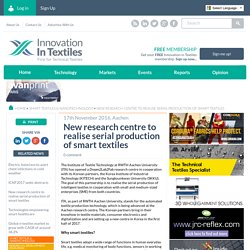
The goal of this partnership is to realise the serial production of intelligent textiles in cooperation with small and medium-sized enterprises (SME) from both countries. ITA, as part of RWTH Aachen University, stands for the automated textile production technology, which is being advanced at the Aachen research centre. The Korean partners bring in their knowhow in textile materials, consumer electronics and digitalization and are setting up a new centre in Korea in the first half of 2017. Nanotechnologies et textile. Researchers develop new fabric that can use sun and wind to power devices. 27th September 2016, Atlanta, GA Researchers at Georgia Institute of Technology have developed a fabric that can simultaneously harvest energy from both sunshine and motion.

According to researchers, combining two types of electricity generation into one textile paves the way for developing garments that could provide their own source of energy to power devices such as smart phones or global positioning systems. “This hybrid power textile presents a novel solution to charging devices in the field from something as simple as the wind blowing on a sunny day,” commented Zhong Lin Wang, a Regents professor in the Georgia Tech School of Materials Science and Engineering.
Flexible, breathable and light weight. Des chercheurs ont mis au point un liquide capable de rafistoler nos vêtements déchirés. Nano Dimension uses multilayer 3D printing to add conductive properties to fabric. 21st September 2016, Ness Ziona Nano Dimension, a leader in the field of 3D printed electronics, has announced that its wholly owned subsidiary, Nano Dimension Technologies, has conducted a successful test for 3D printing of conductive traces onto a treated fabric in collaboration with a leading European functional textiles company.

The test was carried out using Nano Dimension's AgCite Silver Nanoparticle conductive ink and the DragonFly 2020 3D printer platform. Based on the requirements of the European company, Nano Dimension adjusted the printing process in order to print electronics and sensors as an integral part of the fabric. Printing conductors on fabric. Primo1D et RFID dans un fil textile - R&D FUI avec Minalogic - rfid nfc iot ido rtls ble - Internet des Objets Connectés. Avenir de l'industrie textile; entretien avec Christine Browaeys. Nous parlons souvent du point de vue des créateurs sur les textiles innovants mais rarement de celui des ingénieurs et des industriels.
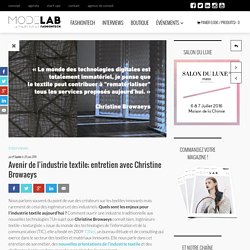
Quels sont les enjeux pour l’industrie textile aujourd’hui ? Comment ouvrir une industrie traditionnelle aux nouvelles technologies ? Un sujet que Christine Browaeys connaît bien. Ingénieure textile « texturgiste », issue du monde des technologies de l’information et de la communication (TIC), elle a fondé en 2009 T3Nel, un bureau d’étude et de consulting qui exerce dans le secteur des textiles et matériaux innovants. Elle nous parle dans cet entretien de son métier, des nouvelles orientations de l’industrie textile et des challenges à relever dans un secteur en plein bouleversement. Modelab : Quel est votre travail au quotidien? Commodity Online. World’s largest rough Diamond fails to meet Lucara’s price expectations Gold is rich at $1,000: Marc Faber The true nature of Gold is liberty Potash price surge could lead to higher food costs The world is going to pay for Brexit By Seshadri RamkumarScientists from UC Berkeley and Google have utilized fabrics made using color changing smart threads to develop computer screens.
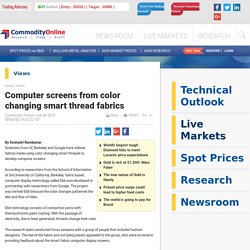
Will this nanowire array let clothes cool us down? A new nanowire array could lead to personal, lightweight cooling units, which could be incorporated into firefighting gear, athletic uniforms, or other wearables.
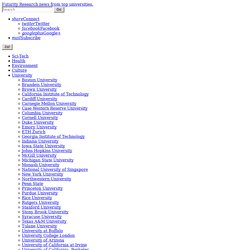
“Most electrocaloric ceramic materials contain lead,” says Qing Wang, professor of materials science and engineering at Penn State. “We try not to use lead. Celliant Announces Calgary Performance Study. Prototype TNF Parka Made Of ‘Synthetic Spiderweb’ Thread. A thread stronger than steel can be spun into next-generation garments with the properties of a spider’s silk.
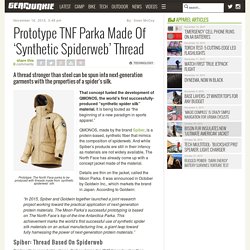
That concept fueled the development of QMONOS, the world’s first successfully-produced “synthetic spider silk” material. It is being touted as “the beginning of a new paradigm in sports apparel.” QMONOS, made by the brand Spiber, is a protein-based, synthetic fiber that mimics the composition of spiderweb. And while Spiber’s products are still in their infancy as materials are not widely available, The North Face has already come up with a concept jacket made of the material.
Details are thin on the jacket, called the Moon Parka. Chinese scientists’ new ‘super-strong foam’ could form lightweight tank and troop armour. Chinese scientists have discovered a “super material” that is as light as a balloon yet as strong as metal, which could be developed by the mainland’s military into armour that protects troops and tanks without sacrificing mobility, a mainland study reports.

The foam-like material was created when tiny tubes of graphene were formed into a cellular structure that had the same stability as a diamond, said the study led by researchers at the Chinese Academy of Sciences’ Shanghai Institute of Ceramics. Graphene, an extremely thin sheet of carbon with extraordinary properties, has attracted great interest among researchers in recent years. It is about 207 times stronger than steel by weight and able to conduct heat and electricity with very high efficiency. However, the new material was able to support something that was 40,000 times its own weight without bending, said the report in the latest issue of the journal, Advanced Materials. Des textiles solaires pour produire de l’électricité. New Applications for Far Infrared Technology. The Seeker has developed a “smart fiber” based on a mechanism of absorbtion / emission of far infrared radiation.
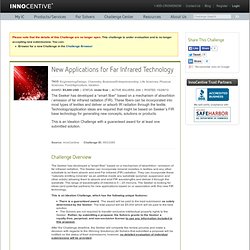
The Seeker can incorporate mineral moieties in textiles and any other substrate to let them absorb and emit Far Infrared (FIR) radiation. They can incorporate these “naturally emitting minerals” as an additive inside any substrate (polymer, suspension and other solids) allowing them to absorb and emit FIR wavelengths and deliver it through the substrate. Cellule photovoltaïque. Un article de Wikipédia, l'encyclopédie libre. Cellule polymère photovoltaïque. Un article de Wikipédia, l'encyclopédie libre. Les cellules photovoltaïques polymères désignent une technique de cellules solaires organiques produisant de l'électricité à partir de la lumière à l'aide de polymères semiconducteurs.
En 2011, il s'agit d'une technique relativement récente étudiée en laboratoire par des groupes industriels et des universités à travers le monde. Encore largement au stade expérimental, les cellules photovoltaïques polymères offrent néanmoins d'intéressantes perspectives. Elles reposent sur des macromolécules organiques dérivées de la pétrochimie, dont les procédés de fabrication sont bien moins consommateurs d'énergie que ceux mis en œuvre pour les cellules à base de semiconducteurs minéraux. Leur coût de revient est bien plus faible et elles sont plus légères et moins fragiles. Principe de fonctionnement[modifier | modifier le code] NanoLeaf - The World's Most Energy Efficient Light LED Light Bulb.
Part 2: Ancient wisdom inspires ‘responsive’ Far Infrared fibres. In this two part feature, Debra Cobb takes a look at a new high-tech wave of interactive functional yarns and fabrics which are designed to deliver a whole range of benefits to wearers. You can read Part 1 at Ancient wisdom inspires ‘responsive’ Far Infrared fibres – Part 1. Part 2 While FIR-reflecting textile technologies Celliant®, Gold Reflect’Line® and energear™ are finding success in highly-technical, health- and performance-oriented products, the polyamide 6.6-based products Emana® and Innergy have generated interest in the softer concepts of well-being, slimming, and cellulite reduction, as well as in performance and recovery during exercise. The intimate apparel market, in particular, has responded well to the polyamide-based fabrics, which take colour well, are easy to wash, and extremely comfortable to wear. Emana The result of four years of research and testing, Emana® was developed by Brazil’s Rhodia Fibras in 2010, and is produced and marketed in Europe by Fulgar.
Doubleskin. Les textiles intelligents - diamantgarfields jimdo page! Les Infrarouges lointains En utilisant des fibres de céramique qui agissent comme des éponges en absorbant et en restituant des rayonnements infrarouges lointains, les fabricants de vêtements sportifs préparent de nouvelles gammes de protection contre le froid. Au contact de l'organisme, les ondes entrent en résonance avec les molécules d'eau qui s'agitent.
What Is Celliant? Celliant is a different kind of performance technology. Decades of development by leading experts in medicine, physics and biology, as well as a dedicated Scientific Advisory Board, has resulted in a proprietary fiber that is loaded with a potent mix of thermo-reactive minerals. Sitemap. Celliant is a different kind of performance technology. Decades of development by leading experts in medicine, physics and biology, as well as a dedicated Scientific Advisory Board, has resulted in a proprietary fiber that is loaded with a potent mix of thermo-reactive minerals.
Powered by our own metabolism, it is more hybrid engine than textile. It recycles and converts radiant body heat into something that gives the body a measurable boost—infrared energy. Over 60% of the energy we consume is lost to escaping body heat. BioPostureTM and Hologenix, LLC Enter Into Licensing Agreement to use Celliant® Fabric for Mattresses. Long Beach, NY (PRWEB) April 16, 2012 BioPosture,TM the leading manufacturer of BioMemoryFoamTM eco-friendly mattresses, pillows and health products has announced it is entering into an exclusive licensing agreement and a strategic partnership with California-based Hologenix, LLC, the makers of Celliant® technology for the health care sector.
The agreement will give BioPostureTM the opportunity to offer consumers its new Evolution Mattress. The mattress incorporates Celliant® technology, a revolutionary responsive textile that harnesses and recycles energy through the medium of fibers, which offers clinically supported health-related benefits. BioPosture’s current product line features an eco-friendly mattress constructed of BioMemoryFoam incorporating a neutral posture support zone developed to offer consumers unmatched comfort with the best ergonomic support during sleep. “Celliant® and BioPosture share the same goal of bringing the latest healthy lifestyle technology to individuals.
Celliant. Celliant. Celliant is a brand-name synthetic polymer bi-component fiber made from polyethylene terephthalate with optically active particles embedded into the core. Created by Hologenix, LLC, fabrics containing Celliant have been shown to increase oxygenation in body tissue and demonstrated to reduce minor aches and pains.[1] Initially marketed as Holofiber, Hologenix changed the name to Celliant to avoid confusion about the nature of the core of its fiber.
Celliant has been shown to interact with electromagnetic emssions (e.g. infrared light) produced by the human body to achieve the increased oxygenation.[2] Applications[edit] Because of oxygenation's performance benefits,[3] Celliant is being used in products by athletic apparel manufacturers like Saucony[4] and Reebok.[5] Celliant is currently being used in bedding, home therapy, medical bandages, and veterinary products.[6] References[edit] External links[edit] Vêtements et accessoires de loisir, de voyage et de sport - Jingo. Les Vêtements à Haute Performance Thermique. Vêtements Zargun, retours d'expériences ? Zyrtex.